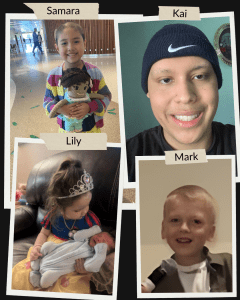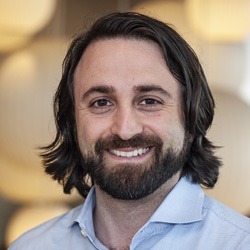A closer look at pediatric brain tumors—and the strength that inspires us every day.
When a child is diagnosed with a brain tumor, it can feel like the world has turned upside down. The path ahead is filled with questions, fear, and unimaginable decisions. Yet, amid the uncertainty, there is hope, and at the heart of that hope are the children who face these challenges with unimaginable bravery.
At the Matthew Larson Foundation for Pediatric Brain Tumors, we are committed to walking alongside families during their most difficult moments. And thanks to the generosity of our donors, IronMatt is a 100% Model Charity, which means 100% of every donation goes directly to funding life-changing research and providing financial support to our IronKids and their families.
We help shoulder the burden so families can focus on what matters most: caring for their child.
The Unique Nature of Pediatric Brain Tumors
Pediatric brain tumors are the most common solid tumors among children and adolescents, with nearly 5,500 new diagnoses in the U.S. each year. Unlike brain tumors in adults, which often develop in the cerebral hemispheres, children’s tumors tend to appear in different, more sensitive areas of the brain—like the brainstem or cerebellum—making treatment more complex and the risks greater.
But every statistic is more than a number.

- It’s a child like Kai, who was diagnosed with a rare brain tumor at just 5 years old.
- It’s Samara, whose strength through treatment inspired her entire hospital floor.
- It’s Lily, who continues to share her smile with her new twin brother and sister.
- It’s Mark whose family fled the war in Ukraine when Mark was just two years old to fight his own battle against a pediatric brain tumor.
Even in the turmoil of scans and surgeries, their courage reminds us that behind every diagnosis is a life worth fighting for.
What Is a Pediatric Brain Tumor?
A pediatric brain tumor is an abnormal growth of cells in the brain or central nervous system (CNS). These tumors can be benign (non-cancerous) or malignant (cancerous), but both can cause serious symptoms because of the pressure they place on delicate areas of the brain.
Pediatric brain tumors behave differently from those in adults. They occur in different regions, grow differently, and respond to treatments uniquely. They’re also the leading cause of cancer-related death in children, which makes early detection and targeted research absolutely essential.
Types and Classifications
The World Health Organization (WHO) classifies pediatric brain tumors by grades:
- Low-grade tumors (Grade I & II) tend to grow more slowly and may have better outcomes.
- High-grade tumors (Grade III & IV) are more aggressive and may require intensive treatment.
Some of the most common types include:
- Pilocytic Astrocytoma – Often slow-growing and found in the cerebellum.
- Medulloblastoma – A common malignant tumor typically located near the brainstem.
- Diffuse Midline Glioma (including DIPG) – An aggressive tumor affecting critical brain structures.
- Ependymoma – Tumors that develop in the lining of the brain’s ventricles.
Understanding the type and grade of a tumor is vital when determining treatment plans and long-term outlook.
Recognizing the Signs: Early Detection Saves Lives
Because pediatric brain tumors often develop silently, early detection can be difficult, but it’s crucial. Some symptoms to watch for include:
- Persistent morning headaches
- Chronic nausea or vomiting
- Vision problems (double vision, squinting)
- Difficulty with balance or coordination
- Seizures with no previous history
- Sudden mood changes or behavior shifts
If something feels “off,” trust your instincts. Parents are often the first to notice subtle changes, and their vigilance can lead to life-saving care.
Progress and Possibility
There’s real hope on the horizon. Researchers are developing targeted therapies—treatments designed to work on the specific biology of each tumor type, offering more effective results with fewer side effects than traditional chemotherapy.
Still, the journey is far from over. Many pediatric brain tumors carry a grim prognosis. And even when treatment is successful, the long-term effects can be life-altering.
That’s why we’re more committed than ever to advancing the impact of IronMatt. In 2025 and beyond, we plan to:
- Diversify & Grow Fundraising: We’ve submitted over 100 grant proposals and letters of interest to foundations nationwide. Our first approvals have already come in.
- Increase Awareness Nationwide: By strengthening our social media presence and building relationships across the country, we plan to connect with more families and supporters.
- Strengthen Hospital Partnerships: We’re building a national network of hospital administrators, social workers, and nonprofits who can help identify and refer families in need.
- Leverage Technology for Greater Efficiency: From streamlining the family assistance application process to simplifying grant tracking, we’re modernizing our systems to help more families faster.
Advancing Research: 100+ Grants and Counting
Since our founding, IronMatt has awarded more than 100 research grants to over 40 institutions, totaling $8.09 million in the fight to cure pediatric brain tumors.
We fund some of the brightest minds in pediatric neuro-oncology, from early-career scientists exploring promising ideas to renowned researchers conducting clinical trials. Thanks to this support, we’ve seen remarkable breakthroughs in:
- Targeted therapies that minimize damage to healthy brain tissue while attacking tumor cells.
- Immunotherapy advancements that offer new hope to children with aggressive tumors like DIPG and DMG, including research into CAR T-cell therapy,
- Improved diagnostic tools for earlier, more accurate detection.
- Survivorship research that focuses on improving quality of life post-treatment.

One of our grant recipients, Dr. Nicholas Vitanza of Seattle Children’s Hospital, is conducting groundbreaking work in CNS CAR T cell trials—a bold step forward in treating DIPG and other high-risk brain tumors. As a 2022 IronMatt Grant Award Winner and now a member of our Medical Advisory Committee,
This is what’s possible because of donors like you: real funding, real breakthroughs, and real hope.
The Matthew Larson Foundation: A Legacy of Love
Our story begins with Matt Larson, a joyful, spirited little boy who lit up every room he entered. Diagnosed with medulloblastoma at just two years old, Matt faced his battle with extraordinary courage. Though he passed away in 2007, his legacy lives on in every IronKid.
Founded by his parents, Kelly and Greg, the Matthew Larson Foundation (also known as IronMatt) was established to ensure no family has to face this journey alone.
Today, IronMatt supports families with emergency financial assistance, funds cutting-edge research, and raises awareness of this devastating disease.
How You Can Help
Every act of kindness fuels our mission. Here’s how you can make a difference:
- Share – Raise awareness by spreading the word about pediatric brain tumors.
- Support – Donate to support research and families in need.
- Engage – Volunteer your time or talents to help us grow our reach.
- Advocate – Join us in calling for increased funding for pediatric cancer research.
Even the smallest action can spark something big. A single post shared on social media could reach the right person at the right time—raising awareness, inspiring a donation, or even changing a life. You never know the difference you might make
Looking Ahead With Hope
Navigating a pediatric brain tumor can feel earth-shattering. But at IronMatt, we strive to build something stronger than fear—a community defined by courage, compassion, and unwavering commitment.
We walk with families, honoring the strength, resilience, and spirit of every IronKid we meet. Their stories are our heartbeat. Their bravery fuels our mission.
Together, we imagine a future where treatments are smarter, outcomes are brighter, and every child has the chance not just to survive—but to grow, thrive, and dream big.
Let’s make that future a reality—one child, one story, one breakthrough at a time.
Join the fight. Support research. Share hope.
Donate Now | Learn More | Share an IronKid Story]




